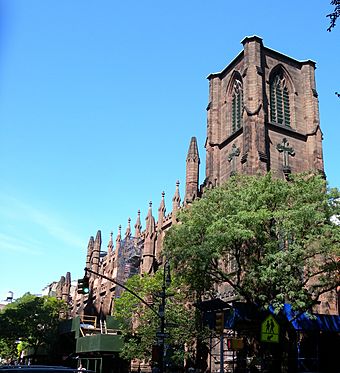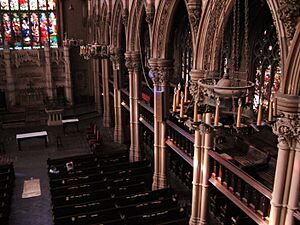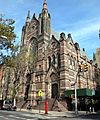- This page was last modified on 17 October 2025, at 10:18. Suggest an edit.
St. Ann & the Holy Trinity Church facts for kids
|
Holy Trinity Church
(Protestant Episcopal) |
|
|
U.S. National Historic Landmark District
Contributing Property |
|

Truncated steeple
|
|
| Location | 157 Montague, Brooklyn, NY |
|---|---|
| Built | 1844-1847 |
| Architect | Minard LaFever |
| Architectural style | Gothic Revival |
| Part of | Brooklyn Heights Historic District (ID66000524) |
| NRHP reference No. | 87002590 |
| Significant dates | |
| Added to NRHP | December 23, 1987 |
| Designated NHL | December 23, 1987 |
| Designated NHLDCP | January 12, 1965 |
The St. Ann & the Holy Trinity Church is a very old and important church in Brooklyn, New York City. It is located in the Brooklyn Heights area, at the corner of Montague and Clinton streets. This beautiful building is an Episcopal church, which means it belongs to a Christian group similar to the Church of England. It is famous for its amazing stained-glass windows and a huge, historic organ.
Contents
A Look at Church History
This church building first opened in 1847. It was originally called the Church of the Holy Trinity. For a while, the church was closed and mostly empty. Then, in 1969, another old church called St. Ann's moved into the building. That's why it's now called St. Ann & the Holy Trinity Church!
The church was designed by a famous architect from the 1800s named Minard Lafever. He was known for his beautiful Gothic Revival style buildings. The amazing stained-glass windows were made by William Jay Bolton and his brother, John Bolton. In 1987, the church was named a National Historic Landmark. This means it's a very special and important place in American history.
A building called a rectory was built next to the church between 1895 and 1897. This building now has a large hall that the church uses for events.
Stained Glass Windows: A Colorful Story
The windows at St. Ann & the Holy Trinity Church are truly special. They were made by William Jay Bolton and his brother, John, between 1845 and 1848. These are some of the very first stained-glass windows in North America that show people and scenes.
There are 55 glass parts in total, making up six different sets of windows. Today, 54 of these beautiful windows are still there. Over the years, these old windows needed a lot of care and repair. Groups like the World Monuments Fund have helped to restore them.
One of these incredible stained-glass windows is so important that it's on display at the Metropolitan Museum of Art in New York City! This window is very tall, about 19 feet high, and shows a musical scene with figures like Miriam and Jubal. It has bright purple and gold colors.
The Mighty Peabody Memorial Organ
The church is also home to a huge and famous organ called the Peabody Memorial Organ. It was built in 1925 by Ernest M. Skinner, a well-known organ builder. This was the third organ to be placed in the church since it opened.
The organ was a gift from a generous church member named George Foster Peabody. He gave it in memory of his brother. This amazing instrument has 4,718 pipes! These pipes range in size from tiny 2-inch ones to giant 32-foot ones. It also has 20 chimes and a 61-note celesta, which is like a keyboard instrument.
In 1999, the Organ Historical Society recognized it as a "Historic Instrument of Special Merit." This is like getting a landmark status for a musical instrument! It is the largest E.M. Skinner organ in all of New York City. Famous organists like Virgil Fox and Louis Vierne from the Cathedral of Notre Dame in Paris have played this incredible organ.
Keeping the Church Beautiful
Many people and groups work hard to keep St. Ann & the Holy Trinity Church in good shape. In 1979, a group called the New York Landmarks Conservancy started a program to help restore the church. They helped fix the main part of the church, restored 64 stained-glass windows, and repaired the fence outside.
In 2014, the church received a grant to help fix the outside of the parish house and its roof. Parts of the stone on the outside were falling apart, and the roofs were leaking. Fixing all the parts of the building is a very big and costly job, estimated to be around $6 million.
Since 2012, a series of events called The Forum at St. Ann's Arts & Culture Series has been held. These events include art shows, movie screenings, poetry readings, and concerts. They help raise money to continue the important restoration work on the church.






